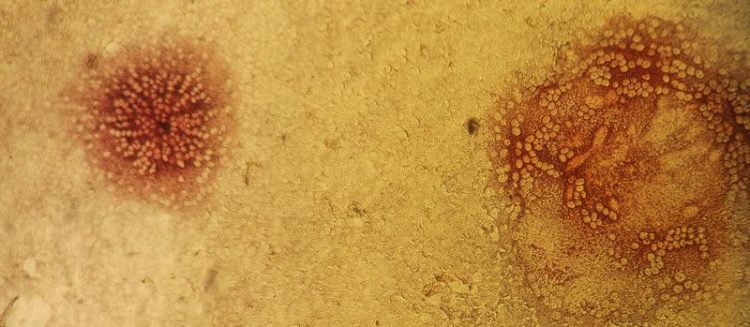Inactivated rabies viruses carrying canine distemper glycoproteins protect against both pathogens

Cells infected with canine distemper virus fuse to neighboring uninfected cells to form syncytia. Antibodies against canine distemper virus are used to stain the infected cells with a red dye Source: PEI
Rabies and canine distemper are among the most dangerous and lethal viral diseases afflicting carnivores. Rabies can also be transmitted to humans via bite from rabies-infected animals. It attacks the nervous system and can be deadly if not treated immediately.
Rabies vaccines contain inactivated virus particles and have an excellent stability and safety profile. For vaccination against canine distemper virus, which causes a measles-like disease in its hosts, live-attenuated viruses are used. These vaccine viruses replicate in the vaccinated animals to a certain extent and can lead to severe disease in highly susceptible species.
Prof. Dr. Veronika von Messling's group at the Veterinary Medicine Division, Paul-Ehrlich-Institut, in collaboration with Dr. Matthias Schnell's group at Thomas Jefferson University genetically engineered the rabies virus vaccine strain to carry one of the canine distemper virus glycoproteins in addition to its own glycoprotein. The protective immune response is directed against these proteins. Candidate vaccines were then produced following the purification and inactivation protocols used for rabies vaccines.
The researchers first demonstrated that a single shot was sufficient to elicit protective rabies antibody titers in ferrets. However, protection against canine distemper was only achieved when animals were immunized with a mix of viruses carrying both canine distemper virus glycoproteins. The researchers conclude that immune responses against both glycoproteins are necessary to protect from canine distemper.
“Our rabies-based vector is a promising platform for the development of new morbillivirus vaccines” explains von Messling. “It eliminates the risk for vaccine-induced disease and at the same time greatly increases the temperature stability compared to live-attenuated morbillivirus vaccines.”
Original Publication
Da Fontoura Budaszewski R, Hudacek A, Sawatsky B, Krämer B, Xiangping Y, Schnell MJ, von Messling V (2017): Inactivated Recombinant Rabies Viruses Displaying Canine Distemper Virus Glycoproteins Induce Protective Immunity Against Both Pathogens.
J Virol Feb 01 [Epub ahead of print].
doi: 10.1128/JVI.02077-16
The Paul-Ehrlich-Institut, the Federal Institute for Vaccines and Biomedicines, in Langen near Frankfurt/Main is a senior federal authority reporting to the Federal Ministry of Health (Bundesministerium für Gesundheit, BMG). It is responsible for the research, assessment, and marketing authorisation of biomedicines for human use and immunological veterinary medicinal products. Its remit also includes the authorisation of clinical trials and pharmacovigilance, i.e. recording and evaluation of potential adverse effects.
Other duties of the institute include official batch control, scientific advice and inspections. In-house experimental research in the field of biomedicines and life science form an indispensable basis for the manifold tasks performed at the institute.
The Paul-Ehrlich-Institut, with its roughly 800 members of staff, also has advisory functions nationally (federal government, federal states (Länder)), and internationally (World Health Organisation, European Medicines Agency, European Commission, Council of Europe etc.).
http://jvi.asm.org/content/early/2017/01/26/JVI.02077-16.abstract – Abstract of the publicaton
http://www.pei.de/EN/information/journalists-press/press-releases/2017/03-inacti… – this press release on the Paul-Ehrlich-Institut Website
Media Contact
All latest news from the category: Health and Medicine
This subject area encompasses research and studies in the field of human medicine.
Among the wide-ranging list of topics covered here are anesthesiology, anatomy, surgery, human genetics, hygiene and environmental medicine, internal medicine, neurology, pharmacology, physiology, urology and dental medicine.
Newest articles

Webb captures top of iconic horsehead nebula in unprecedented detail
NASA’s James Webb Space Telescope has captured the sharpest infrared images to date of a zoomed-in portion of one of the most distinctive objects in our skies, the Horsehead Nebula….

Cost-effective, high-capacity, and cyclable lithium-ion battery cathodes
Charge-recharge cycling of lithium-superrich iron oxide, a cost-effective and high-capacity cathode for new-generation lithium-ion batteries, can be greatly improved by doping with readily available mineral elements. The energy capacity and…

Novel genetic plant regeneration approach
…without the application of phytohormones. Researchers develop a novel plant regeneration approach by modulating the expression of genes that control plant cell differentiation. For ages now, plants have been the…





















